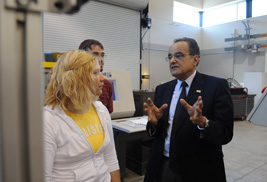Featured Article
Kent State Launches New iPhone Application
Now available on iPhones: Kent State news, events, university directory and map, as well as access to Kent State images and video.
read moreWIRED Grant Implementation Deemed a Success at Kent State Tuscarawas
Posted Oct. 25, 2010Three years after its original implementation, the Workforce Innovation in Regional Economic Development (WIRED) grant program at Kent State University at Tuscarawas is receiving glowing reviews in the final report made to the Department of Labor, the funding agency. Kent State Tuscarawas was one of three recipients of the $5.1 million grant. Other grant partners included Shawnee State University and Ohio University.

Bishara working with students in the lab
Dr. Kamal Bichara, director of the Kent State Tuscarawas Engineering Technology program, is the campus' project manager for the WIRED Grant. "I was pleased to receive the report from the Department of Labor recognizing Kent State Tuscarawas' achievements in reaching its stated objectives for the WIRED grant covering Ohio's Region 10," says Bichara. "The overall goal and objective of the grant was the creation of a digital media production capacity and the direct exposure of high school students to careers in Interactive Digital Technology (IDT), and in the fields of engineering and manufacturing.
"Through the grant, our engineering technology program initially created seven high school Cyber Clubs in 2008 and put a structure in place for its management and sustainability beyond the grant funding period. The clubs expanded to 10 in 2010, incorporating all major schools in the Kent State Tuscarawas service area."
Cyber Clubs were created to introduce students to degree programs and career clusters in the IDT field. They also give students hands-on experience with new advanced technologies. Currently there are more than 250 Cyber Club members, and 32 teachers and school administrators who are Cyber Club Advisory Council members.
The final summary compliments Kent State Tuscarawas for excelling in "developing meaningful connections with employers and with public schools, and for placing "a strong emphasis on applied research, and focusing their efforts on reaching out to students in Appalachia."
In evaluating the outcomes, the report also recognized Kent State Tuscarawas for "ample evidence of the community's support and enthusiasm for the various programs offered through the initiative," exemplified by successful "activities of Cyber Clubs, STEM integration and internships. More than 30 community stakeholders participated in a roundtable discussion that was filled with accolades about the content, approach and value of these programs."
According to Bichara, "We engaged the students in a diverse set of activities including the creation of two islands on Second Life featuring advanced technologies and where sophisticated modern programming and 3-D virtual objects were used. The students also attended several national and international conferences including SIGGRAPH in New Orleans, IEEE, Valve Software in Seattle, and 3DUI and Massachusetts Institute of Technology in Boston."
The final report underscores the importance of the grant in helping local student stretch beyond their geographic boundaries. "With the help of WIRED funds, students in Appalacia who have limited opportunities for travel were able to attend professional conferences," the report says.
"While at the conference, the students were able to attend a number of relevant technical sessions and presentations. They also participated in the educational fair and exhibits, wherein they were exposed to a rich variety of technology and industries."
The Kent State Tuscarawas engineering technology program also supported the creation of Project Lead The Way (PLTW) programs at six area schools in 2008. These schools currently enroll more than 2000 students in a rigorous pre-engineering curriculum. While PLTW does not receive direct WIRED grant funding, the initiative qualified for two grant supported summer academies offering high school students seven one-week long training workshops on various topics including video game design, 3-D character sculpting, computer animation, robotics and control applications.
High school teachers were offered several Train-the-Trainer workshops including Autodesk Inventor, Adobe Flash and Dreamweaver, AutoCad, After Effects and Second Life, to name a few.
Additional grant-funded activities included the Engineering Opportunity Exposition, Engineer for a Day, student art exhibit, an entrepreneurship workshop, a national Bridge Building Contest and seven high school competitions that were held in January 2009 and 2010 for graphic design, game development, digital electronics, robotics and CAD. More than 200 students participated in these competitions during each of the two years.
In addition, 24 paid internships were created for Cyber Club students. "Selected interns worked for three months in an industry dealing with IDT and manufacturing," explains Bichara. "They were each also granted a high-end laptop. The grant also provided a 20-workstation computer lab equipped with the software related to the PLTW and IDT curriculum at each of the 10 Cyber Club high schools."
Reinforced by the positive evaluation received by the Department of Labor, Bichara plans to continue the campus involvement with various existing WIRED activities including Second Life, Cyber Clubs and PLTW. He is working on new funding to continue IT and IDT program expansions at Kent State Tuscarawas.
For more information about these programs, go to the Kent State Tuscarawas website.
By Pam Patacca
